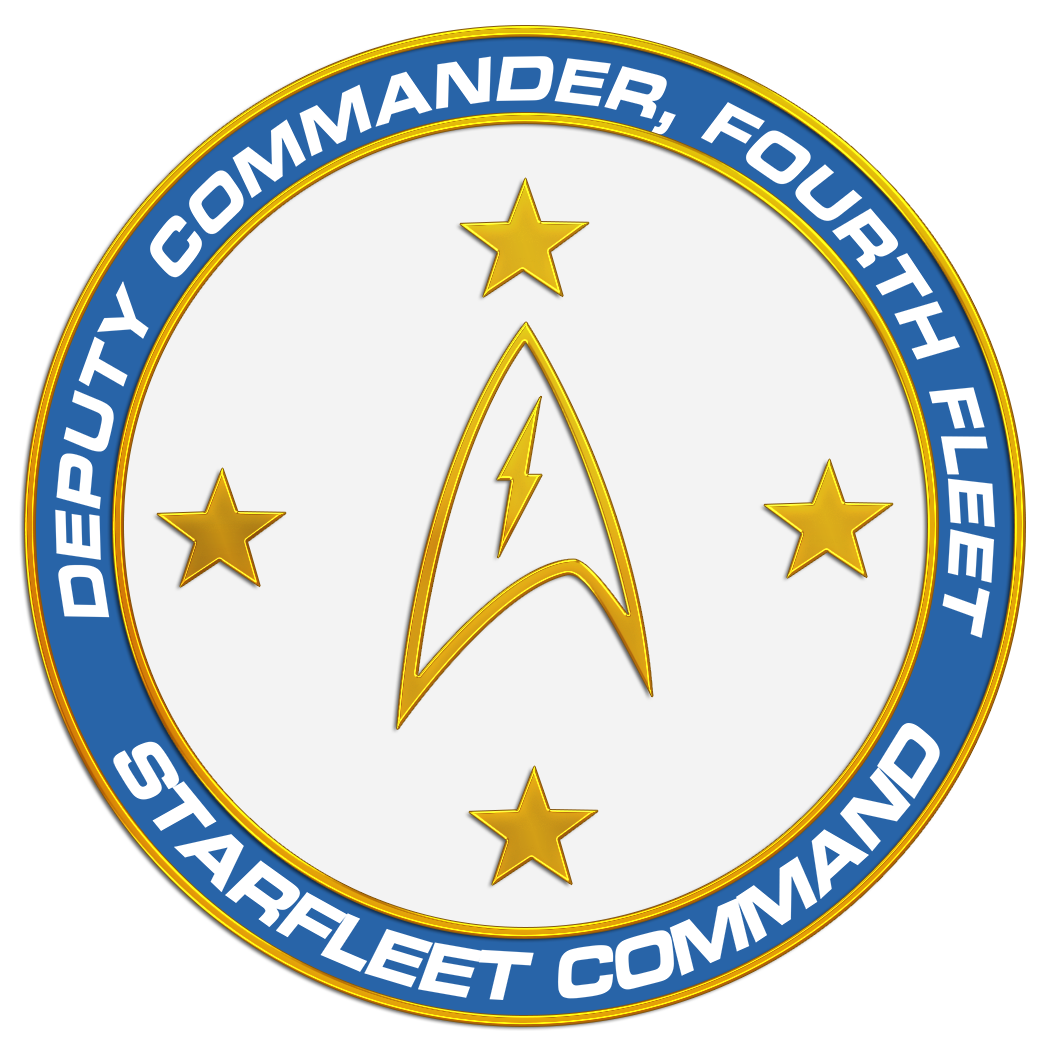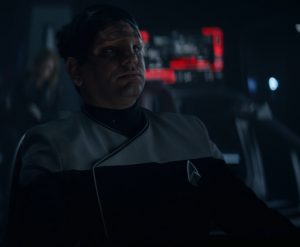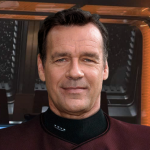Greetings, gentlebeings!
Since the finale of season 3 of Star Trek: Picard, there has been one lingering lore thread that we had yet to resolve: the existence of the grey-uniformed chef of the USS Titan. Clearly intended to be an enlisted member of Starfleet, his insignia appeared to be a single hollow pip, which made us question not only the insignia we had in use for enlisted Starfleet characters, but the enlisted system in general.
Background
An informal survey of writers on Discord and a perusal of the BFMS shows that enlisted characters are infrequently written as main characters in stories, but they’re not uncommon as supporting or background characters. We’ve also noticed in some instances that the difference between commissioned officers and non-commissioned officers is being portrayed as a class distinction, rather than as a difference in training and expertise, which does not fit with the way society in Star Trek is depicted: a classless, socialist utopia. When divisions between members of a crew are depicted, it has generally been a bridge officer vs. lower decker issue (as shown repeatedly on Lower Decks) but it is consistently acknowledged that they’re all just at different places on the same journey (see LDS: “I, Excretus”).
Further, if one does look to real-world counterparts for Starfleet, it’s not the US Navy or even the US Coast Guard: they’re the Commissioned Corps of the U.S. Public Health Service, the NOAA Commissioned Officer Corps, and the NASA Astronaut Corps. All of these entities are officer-only (or a mix of officers and civilians) because of the intense training and education required to be a public health practitioner, environmental scientist, or astronaut. Indeed, Gene Roddenberry stated directly, “There is a feeling of an officer-enlisted man arrangement in this script. Actually, we’ve avoided terminology or playing of ‘enlisted men’ aboard our vessel. Every man aboard is a trained astronaut, even the cooks,” in a memo quoted in The Making of Star Trek. (Earlier in the same book, he is quoted in another memo as saying, “every man and woman aboard the USS Enterprise is the equivalent of a qualified astronaut, therefore an officer,” so the casual sexism in the preceding passage is read as merely an omission.)
Later canon did establish crewmen and non-commissioned officers as canonical, as early as Janice Rand’s status as a yeoman, but her exact career path was not clear until Star Trek: The Motion Picture when she is a transporter chief, with the grade of chief petty officer. Miles O’Brien was also definitively stated to be a senior chief petty officer, though his insignia is extremely problematic until it was settled in mid-TNG and early DS9 as first a hollow pip and then a patch. Besides other miscellaneous and possibly spurious costuming issues, enlisted members and non-commissioned officers in Starfleet have received very little attention, other than O’Brien noting that he never went to Starfleet Academy, but instead “Engineering School” and Mariner mentioning in LDS: “Reflections” that rather than becoming an officer, one could enlist and go to the “Starfleet Technical Services Academy on Mars” to become a transporter chief. O’Brien mentions that Nog technically outranks him, but there’s never any doubt that O’Brien could go to the Academy if he wanted to, but he doesn’t feel that he needs to.
The barriers to entry into Starfleet Academy seem to be limited to two things: aptitude (at least in the sense of being able to pass the admissions exams) and the sponsorship of a command-grade officer (if not a Federation citizen). And on that point, we’re only sure that this is true of Starfleet Academy’s flagship campus in San Francisco. Therefore, anyone with the meritocratic acumen required for entry can become a Starfleet Officer. This also fits with Captain R.M. Merik, captain of the Merchant Marine vessel Beagle, when he noted that the training requirements to join Starfleet were much higher than joining the auxiliary service in TOS: “Bread and Circuses.”
In our canon, thus, the distinction between commissioned officers and non-commissioned officers/enlisted personnel is one of education and training: commissioned officers have university degrees (mostly through Starfleet Academy, but also through Officer Candidate School) in addition to leadership and technical training. Enlisted members and non-commissioned officers either do not have a full university degree or have not gone through as much training in leadership and technical matters. There is a clear pathway to becoming an officer as a non-commissioned officer: completion of the requisite training. It’s clear from canon that junior officers and enlisted personnel both form the “lower decks” of any command. In particular, we see this with how the ensigns on Lower Decks and the TNG episode “Lower Decks” are portrayed.
In terms of insignia, only Miles O’Brien’s patch is technically canonical; all of the grades other than senior chief petty officer have been reverse-engineered from his insignia. Further, in TNG and Voyager we only saw the hollow pip or no insignia at all in use for enlisted folks. In TOS, there was no insignia distinction between ensigns, yeomen, and crewmen. The uniforms from The Wrath of Khan through The Undiscovered Country did have more enlisted variation, but most of what we know about that system comes from the notes of Robert Fletcher rather than on-screen evidence.
From this, we posit that during times of combat or anticipated combat (the cold war of the TOS movies, and the Dominion War of DS9), more of Starfleet was composed of enlisted folks, and thus more distinction in their grades was necessary. During times of peace, Starfleet is composed mostly of officers. Repeatedly, ensigns are given chores and tasks (emptying [redacted] from the holodecks’ [redacted] filters) of the menial variety you might expect for junior enlisted personnel in today’s militaries rather than officers because of the underlying class distinctions still in place there.
Streamlining Enlisted and Non-Commissioned Officer Grades
Both because of the canon evidence and to reduce the minutiae involved with portrayals of enlisted characters, we have decided to pivot towards a streamlined enlisted system with two non-commissioned officer grades (chief petty officer and petty officer) and two enlisted grades (crewman and crewman recruit). We feel that this is the best balance of providing variety for characters while also staying true to what we see in the shows themselves.
Now we get to the chef in Star Trek: Picard. He wore a grey uniform (perhaps mint green, as his counterparts did in The Undiscovered Country) and a single hollow pip. He has had some limited training but is clearly not prepared to be on the bridge of a starship. As a chef, he enlisted and didn’t need training in cookery, just the basic skills necessary to live and work on a starship. His uniform color shows that he’s not a part of the three main divisions of Starfleet: operations, sciences, or command, but rather works in a support role. We envision that this color would be used for chefs, waiters, and non-technical maintenance staff like janitors, hairdressers, barbers, and other recreational support staff.
Given that the system is being streamlined in terms of the grades available, it also is worth noting that the various “senior enlisted advisor” roles like command master chief or chief of the boat (which has repeatedly been misused) no longer make sense in our canon.
Insignia Changes
From the chef’s insignia, we have reverse-engineered a single hollow pip being a petty officer, two hollow pips for chief petty officers, and no insignia for crewmen. We have also consolidated the three grades of petty officers into one title, and sunset the grades of senior and master chief petty officer. Crewmen recruits wear the uniform of a cadet in grey rather than red, and the grade of crewman apprentice has been eliminated. Grey is also added as a color option for crewmen, petty officers, and chief petty officers. To avoid confusion between petty officers and midshipmen, the insignia for that rank has been adjusted to a cadet collar with a hollow pip. You can see the full insignia scheme here on the wiki.
Summary
- The dynamic of an officer/enlisted divide on class or culture basis is inappropriate in a Star Trek context. It’s also unnecessary for there to be a separate enlisted hierarchy as appears in modern militaries because there is a direct pathway from non-commissioned officer to commissioned officer status that is currently much more difficult to obtain.
- We have streamlined the enlisted system, while retaining the three most commonly used grades: crewman, petty officer, and chief petty officer. When these changes are put into effect, you may have to adjust the insignia of characters who used the grades PO2, PO3, SCPO, MCPO, or CA.
- We have added in a grey insignia for support personnel, but only in the enlisted grades.
- In-character, this change happened in 2400, so any characters with service records leading up to that year will still be able to display the full nine-grade system.
- As this is an Intelligence Office decision, there is, obviously, no change to the OCS-controlled fleet rank system; that system remains cadet and officer only.
As with Starfleet Marines, the Starfleet Fighter Corps, warrant officers, the Federation Marshals Service, diplomatic officers wearing purple uniforms, phallic Marine Drop Ships, and a whole host of other things that Bravo Fleet has had at one time or another, the complex enlisted system built on US Military ideas is yet another one that we are discarding because a.) Starfleet is a uniformed service, but it’s not a military (and thus should not have a military culture built around reinforcing class hierarchies, nation-state supremacy, and nationalism—which is the purpose of a military) and b.) a complex enlisted system does not add anything to our writing toolkit. There are plenty of places on the internet where military sci-fi is celebrated, but this isn’t one of them.
So, we hope you enjoy using our simplified, cleaner insignia system! This will be rolled out on the BFMS shortly—folks who had characters with the grades of PO2, PO3, MCPO, SCPO, or CA will need to adjust those insignia to PO, CPO, or CN, as there’s no way for us to do that on this end without editing each character individually.

 Bravo Fleet
Bravo Fleet








